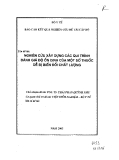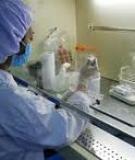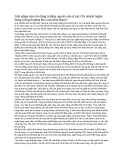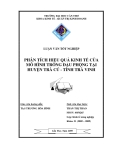J. Vet. Sci. (2004),(cid:1)5(4), 391–395
(cid:1) (cid:2) (cid:3) (cid:4) (cid:5) (cid:6) (cid:7) (cid:8) (cid:2) (cid:9) (cid:10)(cid:11)(cid:12)(cid:11)(cid:13)(cid:14)(cid:15)(cid:16)(cid:13)(cid:17)(cid:8) (cid:18)(cid:19)(cid:14)(cid:11)(cid:15)(cid:19)(cid:11)
Short Communication
Isolation of cholesterol-lowering lactic acid bacteria from human intestine for probiotic use
Hyeong-Jun Lim1, So-Young Kim2, Wan-Kyu Lee1,*
1College of Veterinary Medicine and Research Institute of Veterinary Medicine, Chungbuk National University, Cheongju 361-763, Korea 2Department of Food Science and Technology, and Research Center for Bioresource and Health, Chungbuk National University, Cheongju 361-763, Korea
hydroxy-3-methylglutaryl coenzyme A (HMG-CoA) reductase and acyl CoA: cholesterol acyltransferase (ACAT) have beneficial effects on hypercholesterolemia and arteriosclerosis [12].
Cholesterol-lowering effect of lactic acid bacteria (LAB: Streptococcus, Lactobacillus and Bifidobacterium) is well- known. Thus, we investigated LAB isolated from human intestine on the cholesterol-lowering effect in vitro. Seven Streptococcus (61.1%), 11 Lactobacillus (71.8%) and 7 Bifidobacterium (27.9%) were isolated as acid (pH 2.5 and 3.0) and bile (0.3% oxgall) tolerant strains. Streptococcus HJS-1, Lactobacillus HJL-37 and Bifidobacterium HJB-4 were finally selected as probiotic strains to use through the bile salt hydrolase (BSH) activity assay by using MRS media added taurodeoxycholic acid (TDCA) and the cholesterol-lowering test by using soluble cholesterol containing MRS broth. These studies suggested that the isolated LAB had an excellent hypocholesterolemic effect.
Key words: Lactic acid bacteria (LAB), probiotics, choles- terol, bile salt hydrolase (BSH)
Some natural microorganisms in human intestine are beneficial in terms of lowering serum cholesterol [5,7,18]. lactic acid bacteria (LAB), Lactobacillus and The Bifidobacterium spp. in particular, have the ability to metabolize cholesterol [3]. Blood cholesterol synthesis is decreased by the inhibition of HMG-CoA reductase that convert HMG-CoA to mevalonate and by organic acids in the fermented milk. Gilliland et al. reported that Lactobacillus acidophilus reduces blood cholesterol by direct breakdown of cholesterol and deconjugation of bile salt [9]. In particular, cholesterol metabolism is closely linked to the formation of bile salts, that is, the water-soluble excretory end-products of cholesterol. The bile salts may be transformed by enzyme activities of some intestinal bacteria during the enterohepatic circulation. Bile-salt hydrolase (BSH) is the enzyme responsible for deconjugation of bile acid, and it split glycine or taurine from the steroid moiety, resulting in free (deconjugated) bile salts. BSH activity is observed in some strains associated with the gastrointestinal tract (GIT), representing several species of Lactobacillus, Enterococcus, Peptostreptococcus, Bifidobacterium, Clostridium, and Bacteroides [1].
Cardiovascular disease is the most important cause of death in the westernized countries and it is strongly associated with hypercholesterolemia [17]. Decreasing serum cholesterol is, therefore, very important to prevent cardiovascular disease. HDL-cholesterol has been known to prevent arteriosclerosis by removing cholesterol from blood stream, whereas LDL-cholesterol fastens arteriosclerosis by accumulating cholesterol in the blood vessel [16,17].
This study was to investigate the effects of LAB isolated from human intestine on cholesterol lowering through the BSH activity assay by using MRS media added taurodeoxycholic acid (TDCA) and the cholesterol-lowering test by using soluble cholesterol MRS broth.
The plasma cholesterol concentration can be regulated by the biosynthesis of cholesterol from saturated fat, removal of cholesterol from the circulation, absorption of dietary cholesterol, and excretion of cholesterol via bile and feces. Cellular cholesterol homeostasis is very important for the prevention of cardiovascular disease, and numerous studies have been already reported that enzyme inhibitors for 3-
Fecal specimens were collected from seven healthy humans (3 adult males, 2 adult females and 2 male children) and inoculated into a tube containing 9 ml transport anaerobic media (BHI broth) [19,21] replaced by O2-free CO2 gas. Four plate media were used to isolate LAB, TATAC for Streptococcus, LBS for Lactobacillus, BS for Bifidobacterium and BL for the most part of LAB. Collected
*Corresponding author Tel: 82-43-261-2960; Fax: 82-43-267-3150; E-mail: wklee@cbu.ac.kr
392
Hyeong-Jun Lim et al.
spread onto BL media to discriminate the survival of bacteria and anaerobically incubated at 37oC for 48 hrs. If the colonies were formed on the BL media after 48hrs incubation, they were confirmed as the bacteria to have low pH tolerance [14].
Fig. 2. Bile- salt hydrolase (BSH) activity as detected by the plate-assay method. A, MRS supplemented with 0.5% TDCA (sodium salt of taurodeoxycholic acid) and 0.37% g/l CaCl2; B, MRS as control; Bile-salt hydrolysis positive was represented by black arrow.
In order to assess bile salt tolerance of bacteria, the isolates of Streptococcus, Lactobacillus and Bifidobacterium, were incubated in MRS broth (pH 7.0) containing L-cysteine · HCl · H2O as 0.05% concentration (w/v) at 37oC for 24 hrs under anaerobic conditions. MRS broth was supplemented with 0.3% (w/v) oxgall (Sigma, USA, pH 7.0). All bacteria were inoculated as 30 µl volume and incubated at 37oC for 3 hrs. Then, bacteria were spread onto BL agar plates to confirm the survival of bacteria and anaerobically incubated at 37oC for 48 hrs. If colonies were formed on the BL media, they were decided as the bacteria to have bile salt tolerance [2,14].
feces were serially diluted with the Diluent A, and spread- plated as 10−1, −3, −5, −7 onto TATAC, LBS and BS media and as 10−5, −6, −7 onto BL media [15,21]. Plates were incubated at 37oC for 48 hrs in an anaerobic ‘steel wool’ jar filled with O2-free CO2 gas [20]. Then, typical colonies of LAB were isolated from the cultured media and were transferred onto BL media. They were incubated at 37oC for 24 hrs under anaerobic conditions, and regarded LAB as Streptococcus, Lactobacillus and Bifidobacterium by aerobic growth, Gram’s stain and cell morphology. All isolates were maintained on BL agar plates in the anaerobic conditions and stored at 4oC [15,21]. The bacterial isolation procedure is schematically shown in Fig. 1.
Isolates were screened by being impregnation around sterilized paper disks on the MRS agar plates supplemented with 0.5% (w/v) sodium salt of taurodeoxycholic acid (TDCA, Sigma, USA) and 0.37 g/l CaCl2 (Kanto, Japan) to confirm whether they have bile salt hydrolase (BSH) activity or not. Plates were anaerobically incubated at 37oC for 72 hrs, and the diameter of the precipitation zones around the disks was measured [2,3,4] (Fig. 2).
MRS broth (pH 7.0) containing L-cysteine · HCl · H2O as 0.05% concentration (w/v) was prepared and autoclaved at 121oC for 15 min. Soluble cholesterol (polyoxyethanyl- cholesterol sebacate, Sigma, USA) was supplemented into the prepared MRS broth, and it was filtered through 0.45 µm Millipore. Inoculation volume was 15 µl provisional probiotic bacterial culture solution per 1 ml cholesterol- MRS broth, and that was anaerobically incubated at 37oC for 24 hrs with control. MRS broth without bacterial culture
To assess low pH tolerance, the first isolates, Streptococcus, Lactobacillus and Bifidobacterium, were incubated in MRS broth (Difco, USA) containing L-cysteine · HCl · H2O (Junsei, Japan) as 0.05% concentration (w/v) at 37oC for 24 hrs under anaerobic conditions. MRS broth was adjusted to pH 2.5 (for Streptococcus and Lactobacillus) and pH 3.0 (for Bifidobacterium), respectively, by using 1 N HCl, and put into 3 ml per a 4 ml vial. Streptococcus and Lactobacillus were inoculated into MRS broth (pH 2.5) and Bifidobacterium was inoculated into MRS broth (pH 3.0) as 30 µl volume, then anaerobically incubated at 37oC for 3 hrs. Bacteria were
Fig. 1. Schematic diagrams for the isolation of human intestinal LAB for probiotic use.
Isolation of cholesterol-lowering lactic acid bacteria
393
Table 1. Number of acid- and bile-tolerant lactic acid bacteria isolated from the human intestine for probiotic use
Bileb BSHc Acida
11/18 (61.1)d 28/39 (71.8) 12/43 (27.9) 17/18 (94.4) 37/39 (94.9) 26/43 (60.5) 7/18 (38.9) 5/39 (12.8) 15/43 (34.9) Streptococcus Lactobacillus Bifidobacterium
aLactobacillus and Streptococcus (pH 2.5), Bifidobacterium (pH 3.0) bBile (0.3% oxgall) cBile salt hydrolase activity in the MRS plate media containing taurodeoxycholic acid dNumber of resistant strains/Number of selected strains (%)
Streptococcus and Bifidobacterium, respectively, had BSH activity (Table 1 and Fig. 2). Streptococcus HJS-1 produced large precipitation zone (19 mm). But only 5 strains (12.8%) among Lactobacillus had BSH activity.
solution was also incubated at 37oC for 24 hrs for the control. An Ektachem DT 60 analyzer (Johnson & Johnson, USA) was used to measure remaining volume of cholesterol in the cholesterol-MRS broth. The incubated cholesterol-MRS broth with isolates was centrifuged at 3000 rpm for 10 min. Ten micro liter supernatant was collected with a DT pipette. The supernatant was reacted with slide reagent on the DT slide. In order to measure cholesterol amount, dye layer is observed in 555 nm wave length.
Total 51/100 (51.0) 80/100 (80.0) 27/100 (27.0)
In vitro cholesterol-lowering test: Among isolated 100 strains of LAB, 7 of Streptococcus strains, 11 of Lactobacillus strains and 7 of Bifidobacterium strains were selected as provisional probiotic strains due to their superiority on low pH and bile salt tolerance and BSH activity assay (Table 2).
Final isolates, Streptococcus and Lactobacillus, were aerobically incubated at 28oC for 24 hrs on MRS agar plates, and Bifidobacterium was anaerobically incubated at 35oC for 48 hrs on BL agar plate. Bacteria were preprocessed with reagents to extract fatty acid from the bacterial cell-wall and identified with microbial identification system (MIDI, Inc., USA).
Among Streptococcus strains, the Streptococcus HJS-1 decreased cholesterol concentration from 203.3 mg/dl to 87.5 mg/dl (57.0%) in the MRS broth without bile salt and to 102.9 mg/dl (49.4%) in the 0.3% bile salt MRS broth. Eight strains of Lactobacilli decreased cholesterol by more than 50% in the MRS broth regardless to the presence of bile salt. Bifidobacterium HJB-4 and Bifidobacterium HJB-25 reduced cholesterol by about 50% in the MRS broth regardless the presence of bile salt. These results showed that many LAB have a great cholesterol-lowering activity in the MRS broth regardless to the presence of bile salt (0.3% oxgall) (Table 2).
Isolation of bacteria: One hundred strains of LAB were isolated from selective (TATAC, LBS and BS) and non- selective (BL) media; 18 Streptococcus strains, 39 Lactobacillus strains and 43 Bifidobacterium strains. The number of Streptococcus isolated from 7 volunteers was 102~107 CFU/ml, Lactobacillus was 103~108 CFU/ml and Bifidobacterium was 106~109 CFU/ml. In particular, the number of Bifidobacterium was higher than those of other LAB.
Identification of final isolates: As considering bacterial preparation such as low pH and bile salt tolerance, BSH activity, in vitro cholesterol-lowering activity and so on, we selected LAB strains finally from human intestine for probiotic use. The final selected probiotic bacteria were and Streptococcus HJS-1, Lactobacillus HJL-37, Bifidobacterium HJB-4.
37,
1, Lactobacillus-HJL
Low pH tolerance: Low pH tolerance of isolated LAB was assessed in pH 2.5 (Streptococcus and Lactobacillus) and in pH 3.0 (Bifidobacterium). As shown in Table 1, 61.1% in Streptococcus strains (11/18 strains) and 71.8% in Lactobacillus (28/39 strains) were also tolerant in pH 2.5. In case of Bifidobacterium, 27.9% (12/43 strains) were tolerant in pH 3.0. In addition, Bifidobacterium was the weakest in low pH conditions among isolated LAB.
Finally selected probiotic bacteria were identified using the microbial identification system (MIDI, HP Inc., USA). and Streptococcus-HJS Bifidobacterium-HJB 4 were identified as Enterococcus faecium (Similarity index (SI): 0.601), Lactobacillus delbrueckii (SI: 0.521), and Bifidobacterium longum (SI: 0.467), respectively.
Bile salt tolerance: Results of bile salt tolerance were shown in Table 1. Among LAB, 94.4% in Streptococcus (17/18 strains), 94.9% in Lactobacillus (37/39 stains) and 60.5% in Bifidobacterium (26/43 strains) were tolerable to bile salt. Most bacteria were tolerable to bile salt but Bifidobacterium was relatively weak compared to other LAB in bile salt tolerance assay.
Bile salt hydrolase (BSH) activity assay: As shown in Table 1, 38.9% (7/18 strains) and 34.9% (15/43 strains) in
Cardiovascular disease is the most important cause of death in Korea and in the western countries. In the United States, 10 million people suffer from ischemic coronary arterial diseases, and spend 115 billion dollars per year to treat it. According to NHANES (the third national health and nation examination survey) data and NCEP (national
394
Hyeong-Jun Lim et al.
for cholesterol
Table 2. Change in cholesterol level after in in vitro incubation with selected LABa
Strain No. Oxgall concentration [mg/dl] (Reduction rates of cholesterol [%])
0% 0.3%
loss of bile salts may indeed result in an increased for maintaining serum requirement cholesterol levels. Klaver and van der Meer suggested that in vitro cholesterol reduction by some Lactobacillus spp. results from its coprecipitation with deconjugated bile salts [13]. De Smet et al. suggested that highly BSH-active Lactobacillus spp. may reduce serum cholesterol levels [2], and they hypothesized that BSH activity may be an important factor for bile tolerance [3]. BSH-active lactobacilli may thus have an advantage to survive and colonize in the lower small intestine where the enterohepatic circulation takes place.
Control 203.3 (0) 203.3 (0)
Streptococcus HJS-1 Streptococcus HJS-3 Streptococcus HJS-6 Streptococcus HJS-9 Streptococcus HJS-11 Streptococcus HJS-12 Streptococcus HJS-17 087.5 (57.0) 149.5 (26.5) 152.6 (24.9) 157.4 (22.6) 150.1 (26.2) 203.5 (0) 168.3 (17.2) 102.9 (49.4) 166.1 (18.3) 169.5 (16.6) 174.9 (14.0) 176.6 (13.1) 203.9 (0) 182.9(10.0)
Lactobacillus HJL-4 Lactobacillus HJL-20 Lactobacillus HJL-24 Lactobacillus HJL-25 Lactobacillus HJL-30 Lactobacillus HJL-32 Lactobacillus HJL-33 Lactobacillus HJL-34 Lactobacillus HJL-37 Lactobacillus HJL-38 Lactobacillus HJL-39 086.1 (57.6) 125.1 (38.5) 117.6 (42.2) 107.0 (47.4) 071.1 (60.0) 083.2 (59.1) 092.6 (54.5) 069.4 (65.9) 072.4 (64.4) 067.5 (66.8) 085.3 (58.0) 092.6 (54.5) 139.3 (31.5) 130.7 (35.7) 121.6 (40.2) 088.9 (56.3) 104.9 (48.4) 101.8 (49.9) 086.7 (57.4) 085.2 (58.1) 084.4 (58.5) 100.3 (50.7)
In general, probiotic bacteria must colonize in GIT of host, have acid- and bile salt-tolerance and be antagonist against putrefactive bacteria in GIT [4,9]. In this study, Streptococcus, Lactobacillus and Bifidobacterium from human intestine were selected as optimal probiotic bacteria. Low pH- and bile salt-tolerance were assessed for 100 probiotic isolates. Eleven Streptococcus strains (61.1%), 28 Lactobacillus strains (71.8%), and 12 Bifidobacterium strains (27.9%), were selected as provisional probiotic strains. As considered with BSH activity, and in vitro cholesterol-lowering test, the final probiotic strains were 7 in Streptococcus strains, 11 in Lactobacillus strains and 7 in Bifidobacterium strains. In this study, Streptococcus HJS-1, Lactobacillus HJL-37 and Bifidobacterium HJB-4 had the best hypocholesterolemic effects (57.0%, 64.4% and 58.6%, respectively) in the MRS broth with soluble cholesterol containing 0.3% oxgall. From present results, it was suggested that the finally isolated LAB had an excellent hypocholesterolemic effect. They will be use as a probiotics to prevent hypercholesterolemia for human health. However, the mechanisms of regulating serum cholesterol and the effect on the serum cholesterol level in vivo animal experiment needs further extensive investigations.
Bifidobacterium HJB-4 Bifidobacterium HJB-23 Bifidobacterium HJB-25 Bifidobacterium HJB-33 Bifidobacterium HJB-34 Bifidobacterium HJB-35 Bifidobacterium HJB-39 084.2 (58.6) 172.7 (15.1) 083.1 (59.1) 173.0 (14.9) 151.3 (25.6) 143.2 (29.6) 201.0 (1.1) 105.3 (48.2) 191.9 (5.6) 103.9 (48.9) 192.2 (5.5) 178.0 (12.4) 168.5 (17.1) 201.1 (1.1)
Acknowledgments
aAmounts of cholesterol were measured after 36 hrs incubation at 37oC with acid (Streptococcus and Lactobacillus; pH 2.5, Bifidobacterium; pH 3.0) and bile (0.3% oxgall) tolerant LAB isolated human intestine in MRS broth containing cholesterol with (0.3%) or without oxgall.
This work was supported by Chungbuk National
University Grant in 2004.
References
to
1. Canzi E, Zanchi R, Camaschella P, Cresci A, Greppi GF, Orpianesi C, Serrantoni M, Ferrari A. Modulation by lactic acid bacteria of the intestinal ecosystem and plasma cholesterol in rabbits fed a casein diet. Nutr Res 2000, 20, 1329-1340.
2. De Smet I, van Hoorde L, De Saeyer N, vande Woestyne M, Verstraete W. In vitro study of bile-salt hydrolase (BSH) activity of BSH isogenic Lactobacillus plantarum 80 strains and estimation of cholesterol lowering through enhanced BSH activity. Micro Ecol Health Dis 1994, 7, 315-329.
cholesterol education program) guide, half million people have died of ischemic cardiac disease. Fifty two million US people are recommended to eat a diet to decrease their serum cholesterol, and 13 million people need a treat cardiac diseases. Recently, pharmacotherapy considerable researches on the favorable health effects of probiotics have been recently reported. The probiotics have been known to mitigate the risk of arteriosclerosis associated with dyslipoproteinemia, obesity, and diabetes. [1,8,11,22,23] It was hypothesized that deconjugation of bile salts may contribute to lower cholesterol levels as free bile salts may be excreted more likely from the GIT than conjugated bile salts [6]. However, the hypothesis is disputable and incompatible with current knowledge with regard to the passive absorption kinetics of free bile salts in the GIT. Fecal
3. De Smet I, van Hoorde L, vande Woestyne M, Christiaens H, Verstraete W. Significance of bile-salt hydrolytic
Isolation of cholesterol-lowering lactic acid bacteria
395
74.
13. Klaver FAM, van der Meer R. The assumed assimilation of cholesterol by Lactobacillus and Bifidobacterium bifidum is due to their bile salt-deconjugation activity. Appl Environ Microbiol 1993, 59, 1120-1124.
activities of lactobacilli. J Appl Bacteriol 1995, 79, 292-301. 4. Du Toit M, Franz CMAP, Dicks LMT, Schillinger U, Haberer P, Warlies B, Ahrens F, Holzapfel WH. Characterization and selection of probiotic lactobacilli for a preliminary minipig feeding trial and their effect on serum cholesterol levels, faeces pH and faeces moisture content. Int J Food Microbiol 1998, 40, 93-104.
14. Kimoto H, Kurisaki J, Tsuji NM, Ohmomo S, Okamoto T. Lactococci as probiotic strains: adhesion to human enterocyte-like Caco-2 cells and tolerance to low pH and bile. Lett Appl Microbiol 1999, 29, 313-316. 5. Fernandes CF, Shahani KM, Amer MA. Therapeutic role of dietary lactobacilli and Lactobacillus fermented dairy products. FEMS Microbiol Rev 1987, 46, 343-356.
15. Lee WK, Lee SM, Bae HS, Y. J. Baek YJ. Effect of Bifidobacterium longum HY8001 administration on human fecal bacterial enzyme and microflora. Korean J Appl Microbiol Biotechnol 1999, 27, 267-272. 16. Lee YW. Effect of fermented milk on the blood cholesterol 6. Fukushima M, Fujii S, Yoshimura Y, Endo T, Nakano M. Effect of rice bran on intraintestinal fermentation and cholesterol metabolism in cecectomized rats. Nutr Res 1999, 19, 235-245. level of Korean. J Food Safety 1997, 12, 83-95.
17. Lee YW, Roh WS, Kim JG. Benefits of fermented milk in rats fed by hypercholesterolemic diet (II). Korean J Food Hygiene 1992, 7, 123-135. 7. Fukushima M, Yamada A, Endo T, Nakano M. Effects of a mixture of organisms, Lactobacillus acidophilus or Streptococcus faecalis on delta6-desaturase activity in the livers of rats fed a fat- and cholesterol-enriched diet. Nutrition 1999, 15, 373-378.
18. Mann G.V, Spoerry A. Studies of a surfactant and cholesterolemia in the Massai. Am J Clin Nutr 1974, 27, 464- 469.
8. Gallo LL. Cholesterol and other sterols: absorption, metabolism, roles in atherosclerosis. In: Watson RR (ed.). Nutrition and heart disease. pp. 83-109, Churchill Livingstone, London, 1983. 19. Oh CY, Lee WK Cholesterol lowering effect of lactic acid bacteria isolated from the human intestine. Korean J Vet Public Health 2000, 24, 181-188. 20. Parker CA. Anaerobiosis with iron wool. Aust J Exp Biol Med Sci 1955, 33, 33-37. 9. Gilliland SE, Nelson CR, Maxwell C. Assimilation of cholesterol by Lactobacillus acidophilus. Appl Environ Microbiol 1985, 49, 377-381. 21. Mitsuoka T. The World Anaerobic Bacteria. pp. 13-65. 10. Gilliland SE. Health and nutrition benefits from lactic acid Sobun Press. Tokyo, 1980. bacteria. FEMS Microbiol Rev 1990, 7, 175-188.
22. Mutai M, Tanaka R. Ecology of Bifidobacterium in the human intestinal flora. Bifidobacteria Microflora 1987, 6: 33- 41. 11. Gilliland SE, Walker DK. Factors to consider when selecting a culture of Lactobacillus acidophilus as a dietary adjunct to produce a hypocholesterolemic effect in humans. J Dairy Sci 1990, 73, 905-911.
23. Park SY, Bok SH, Jeon SM, Park YB, Lee SJ, Jeong TS, Choi MS. Effect of rutin and tannic acid supplements on cholesterol metabolism in rats. Nutr Res 2002, 22: 283-295 12. Hay JM, Yu WM, Ashraf T. Pharmacoeconomics of lipids- lowering agents for primary and secondary prevention of coronary artery disease. Pharmacoeconomics 1999, 15, 47-




































